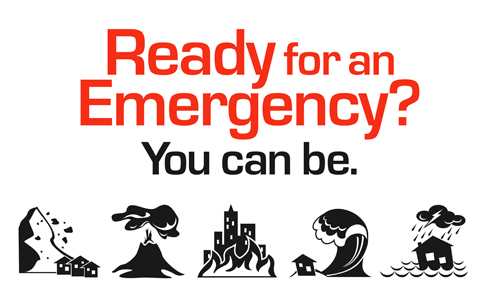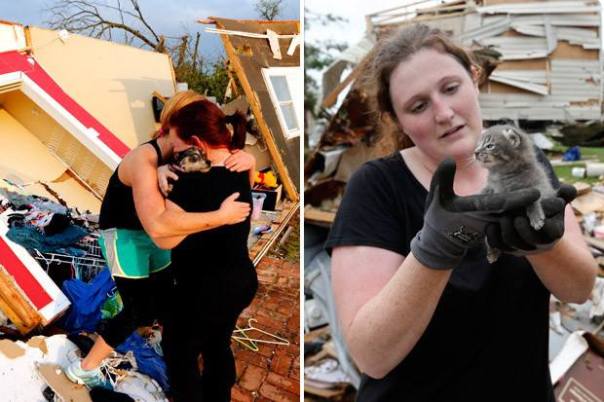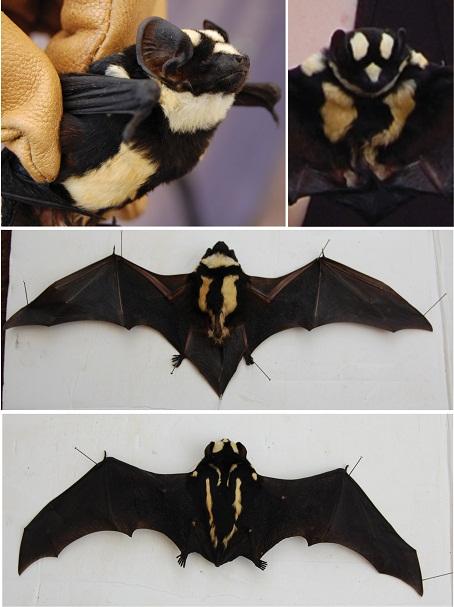
In light of the recent catastrophic events in Moore Oklahoma, it is a poignant reminder to all of us to prepare for disasters, no matter what form it takes. Here in the Pacific Northwest region, we are at risk for earthquake activity, owing to the many fault lines that run along the Pacific coastline, as well as effects of tsunamis. Many low-lying areas are also prone to flooding, and tornadoes–while rare in this region–are not out of the question. No matter what area of the country you live in, there are potentials for severe events, both natural and unnatural–there is no place in this country that is guaranteed 100% safe and insulated from something unfortunate happening; you may not get tornadoes but you may get wind-storms that can knock out power and block roads with downed trees for days; you may not get hurricanes but you may get flooded. We must take preparations to be able to survive on our own for a period of time, and ensure the survival of those who depend on us, such as our companion animals.

After being lucky enough to survive an initial disaster, the infrastructure we depend on may not be functional; there may no longer be access to food or running water, electricity or shelter, so planning ahead for such contingencies increases your chance of surviving for a period of time in case rescue crews or relief supplies are not able to reach you for a few days. Especially after a substantially destructive event with widespread damage, help may not come for some time (after the Moore tornado, first-responders at first were not able to get into the affected neighborhoods because of the extensive amount of debris blocking roadways), so it is best to plan ahead; imagine taking a camping trip for a week and you’ll get some idea of what you’ll need. Speaking of camping, many of us in this region do so, so there is the added advantage of having those supplies and gear at our disposal. Failing that, you can compile such items now and it will serve the dual purpose of being available for that trip you’ve been wanting to take in the mountains.
It will take some time and money to compile these kits, but it is important to start now and add to it as time and money allows; every little bit you add will greatly improve your situation later should the unthinkable happen. We recommend compiling one go-kit for each member of your household, including special items for your companion animal(s), and stowing camping gear in your available vehicles. There are special items you can compile for the home, but be aware that after a flood, earthquake, or tornado, your residence may be compromised enough to be unsafe for habitation, if it is left standing at all.
Vegans will have to ensure that there is enough food stocked up and packed away. Relief supplies, once they come, may not be all vegan, so having enough food for at least 7 days is recommended. Energy bars are convenient, especially in the Go-Kits, but they are expensive. Better to stock up at home on canned soups, beans and vegetables, dried fruit, nuts, and avoid foods like rice, noodles, and instant mixes as they require heat and a lot of precious water to prepare. There are now available quite a few packaged vacuum-sealed meals (usually Indian or Thai curries) that are vegan.
Another consideration for vegans is the inclusion of first-aid kits. There are many pre-packaged first-aid kits on the market, but many of them have products either with animal ingredients or are manufactured by companies that conduct testing on animals. It is better to make your own, using items from safe manufacturers. A list of recommended items are below.
Discuss an evacuation plan with all members of your household and how to notify each other in case of separation. Note that phone and internet communication networks may either be inoperable or overloaded, but establish an out-of-town/state contact person that each person can check in with, or use the same social networking sites. Discuss alternate meet-up places. If you have children, make sure they know their basic personal information should they get separated, know alternate contacts and meeting sites, and role-play with them on what to do and where to go as well as how to get hold of 911 and other contacts.
Your companion animals need special attention and planning. Make sure any licenses are current, and each animal has an ID tag. Consider micro-chips. Keep an updated list of trusted neighbors who could assist your companion animals in case of an emergency. Make sure they are comfortable being inside carriers. Fasten down aquariums and other cages to their tables to prevent them from tipping over. If you evacuate, locate all your animals and keep them with you. Be aware that shelters will only allow service animals. In a large-scale disaster, animal shelters will be set up when possible.
If there is absolutely no way to take your companion animals with you, inform animal rescue workers of your pets’ status: On your front door or in a highly visible window, use chalk, paint or marker to write the number and types of pets in your residence. Include their location in your home and the date that you evacuated. Leave plenty of water in a large, open container that cannot be tipped over. Leave plenty of food in timed feeders to prevent your pet from overeating. Absolutely do *not* tie up your pet in your home. The first chance you can get communications, find out who among neighbors, friends, or rescue workers can get to your place.
The old adage “an ounce of prevention is worth a pound of cure” is never as critical to follow as preparing for a disaster. It is worth it to start now, and even if you cannot afford to get everything at this point get what you can, and continue to build upon your kits, because every little bit will prove to be invaluable should the unexpected happen. And especially for those of us who have others who depend on us, like companion animals, and those who are living as vegans, it is important to place extra consideration to ensure that as many living beings survive as possible.
FIRST-AID KIT (in a small plastic container)
+ First-aid manual
+ Sterile gauze pads of different sizes
+ Adhesive tape
+ Adhesive bandages in several sizes
+ Elastic bandage
+ A splint
+ Antiseptic wipes
+ Soap
+ Antibiotic ointment
+ Antiseptic solution (like hydrogen peroxide)
+ Cold packs/Heat packs (wrap in towel prior to use)
+ Tweezers
+ Sharp scissors
+ Safety pins
+ Disposable gloves
GO-KIT (in a backpack)
+ LED-flashlight
+ First-aid kit (as noted above)
+ Bottled water
+ Dried food like soy jerkies, energy bars, dried fruit, granola, etc.
+ Permanent marker, paper, tape to leave behind notes
+ Whistle
+ Flare or warning light to signal planes/helicopters
+ Multi-tool knife
+ Matches in waterproof container or cigarette lighter
+ Rain poncho
+ Warm hat/gloves
+ Sturdy shoes
+ A change of clothes
+ Emergency Mylar blanket (aka thermal blanket, Space Blanket, first-aid blanket)
+ Extra glasses, contact cases, contact solutions, other vital personal items
+ Prescription medication
+ Travel-size toothpaste and toothbrush
+ Photos of family members/companion animals for ID purposes
+ Copy of health insurance and identification cards
+ List of emergency point-of-contact phone numbers
+ Extra keys
+ Emergency cash in small denominations
COMPANION-ANIMAL GO-KIT (in a shoulder bag)
+ Carrier with blanket (Store with bag)
+ Sturdy leashes and muzzles for dogs.
+ Food, potable water and medicine/supplements for at least one week
+ Non-spill bowls, manual can opener (if using canned food)
+ Plastic bags for sanitation
+ Recent photo of each pet
+ Names and phone numbers of your emergency contact, emergency veterinary hospitals and animal shelters
+ Copy of your pet’s vaccination history and any medical problems
+ Favorite toy
+ A pillowcase may be a good emergency transport for cats and other small animals
HOME KIT (in large plastic tub)
+ Water*
+ Food (as noted above)
+ Manual can-opener
+ First-aid kit (as noted above)
+ Crowbar (doors that are shut may be jammed)
+ Dust-masks
+ Non-leather heavy-duty work gloves
+ Hand-powered radio
+ Flashlight/batteries
+ Plastic sheeting/duct-tape to cover up broken windows
+ Bucket/heavy plastic bags for sanitation (toilets may not function)
+ Personal hygiene items including toilet paper, feminine supplies, hand sanitizer and soap
+ Rope/twine
+ Plastic tarps
+ A copy of important documents & phone numbers
+ Tools; hammer, nails, staple gun, hacksaw/pruning saw
+ For children provide comfort food and treats, and games
It would be a good idea to store a crowbar, dust-mask (to filter out drywall, insulation, and other dust shaken loose), sturdy shoes, flashlight, and glasses (if you need corrective vision) next to your bed.
CAR KIT (to supplement Go-Kit)
+ Water*
+ Food (as noted above)
+ Sleeping bag(s)
+ Tent
+ Camping mess kit (forks, spoons, knives, metal pots/cups/plates)
+ Camp stove, or matches/cigarette lighter for building camp-fires
+ Extra blankets
+ Flashlight/batteries
+ First-aid kit (as noted above)
+ Emergency road-side kit (usually includes flares and tools)
+ In-car chargers for cell-phones and other communication devices
+ CB Radio
+ Change of clothes
+ Warm hat/gloves
*A SPECIAL NOTE ABOUT WATER:
In a disaster, water supplies may be cut off or contaminated. Store enough water for everyone in your family to last for at least 3 days. Store one gallon of water per person, per day. Three gallons per person per day will give you enough to drink and for limited cooking and personal hygiene. Remember to plan for your companion animals.
If you store tap water:
Tap water from a municipal water system can be safely stored without additional treatment. Store water in food grade plastic containers, such as clean 2-liter soft drink bottles. Heavy duty, reusable plastic water containers are also available at sporting goods stores. Empty milk bottles are not recommended because their lids do not seal well and bottles may develop leaks. Label and store in a cool, dark place. Replace water at least once every six months.
If you buy commercially bottled “spring” or “drinking” water:
Keep water in its original container, and don’t re-store a bottle once it’s been opened. Store in a cool, dark place. If bottles are not marked with the manufacturer’s expiration date, label with the date and replace bottles at least once per year.
Treating water after a disaster:
If you run out of stored drinking water, strain and treat water from your water heater or the toilet reservoir tank (except if you use toilet tank cleaners). Swimming pool or spa water should not be consumed but you can use it for flushing toilets or washing.
Treatment process:
Strain any large particles of dirt by pouring the water through layers of paper towels or clean cloth. Next, purify the water one of two ways:
Boil – bring to a rolling boil and maintain for 3-5 minutes. After the water cools, pour it back and forth between two clean containers to add back oxygen; this will improve its taste.
Disinfect – If the water is clear, add 8 drops (1/8 teaspoon) of bleach per gallon of water. If it is cloudy, add 16 drops (1/4 teaspoon) per gallon. Make sure you are using regular bleach— 5.25% percent sodium hypochlorite— rather than the “ultra” or “color safe” bleaches. Shake or stir, then let stand 30 minutes. A slight chlorine taste and smell is normal.
A SPECIAL NOTE ABOUT EARTHQUAKES:
In an earthquake, since it happens suddenly and without warning, it is important to know what to do. It is a myth that the safest place is under a doorway; in modern structures, the doorway is no stronger than the rest of the building–in fact, you’re likely to get injured from doors swinging wildly, and if it’s a public building, people may shove past you to hurry through. Instead, drop, get under cover, and hold on. Many people make the mistake of standing, running, or trying to keep furniture from falling over—all major earthquake no-nos. When an earthquake strikes, don’t run or try to escape. Search for cover as close to you as possible; if you’re in bed, stay curled up and protect your head with a pillow. If you’re driving, pull over to the side when it’s safe, and stay off bridges and going underneath overpasses.


